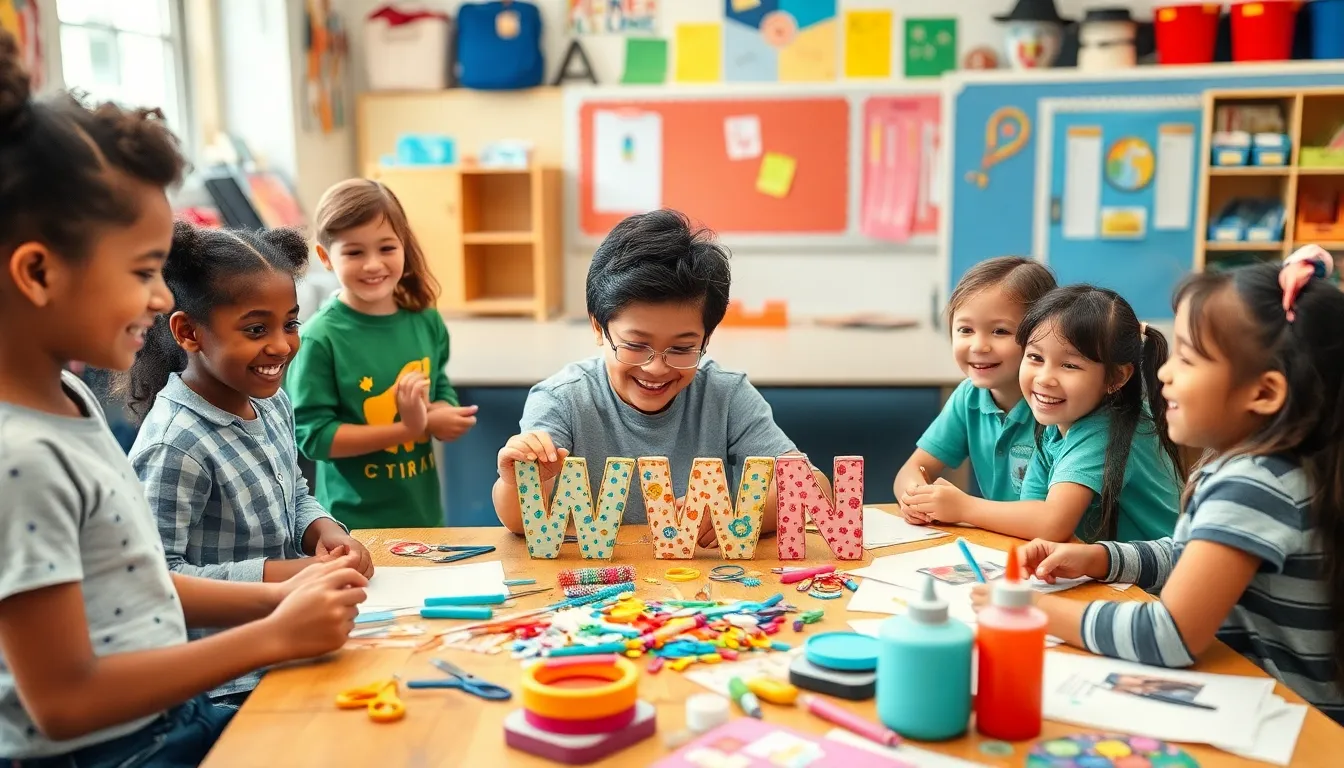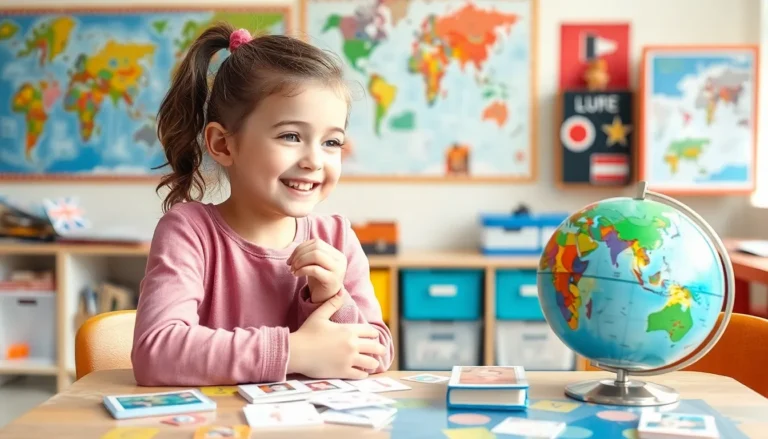Language craft projects are the secret sauce to turning bland vocabulary lessons into vibrant, hands-on experiences. Imagine a world where learning new words doesn’t involve dusty textbooks or monotonous drills. Instead, it’s all about glue, glitter, and a dash of creativity. These projects not only make language fun but also help students grasp concepts in a way that sticks—like that one stubborn piece of tape you can never find the end of.
Whether it’s creating a word wall that rivals a modern art gallery or crafting quirky sentence sculptures, these activities spark imagination and boost engagement. Who knew that a little yarn and some construction paper could unlock the door to language mastery? Dive into the colorful realm of language craft projects and watch as students transform into enthusiastic word wizards, ready to tackle any literary challenge that comes their way.
Table of Contents
ToggleOverview of Language Craft Projects
Language craft projects integrate creativity into vocabulary lessons, offering students an engaging alternative to traditional learning methods. Projects like crafting word walls enhance visibility and recognition of vocabulary words, making retention easier. Crafting sentence sculptures encourages creativity while allowing students to manipulate language structure hands-on.
Incorporating these projects fosters a dynamic learning environment. Students actively participate, enhancing their understanding of language concepts. Creating visual aids and tactile materials assists learners in grasping abstract language rules.
Teachers can facilitate collaborative projects, further boosting engagement and teamwork skills. Group activities promote a sense of community, encouraging students to share ideas. Implementing artful techniques captures students’ attention, leading to better enthusiasm for language learning.
The outcomes of language craft projects are significant. Students develop improved vocabulary and grammar skills. Creativity applied to language learning reveals its playful nature, transforming perceptions of education. Makerspaces and workshops provide excellent venues for executing these projects effectively.
Overall, language craft projects present clear benefits. They encourage effective learning through play, breaking down barriers often associated with traditional pedagogy. Implementing such projects creates memorable experiences, reinforcing language skills in a creative and enjoyable way.
Benefits of Language Craft Projects

Language craft projects provide numerous advantages, particularly in vocabulary acquisition. These benefits manifest in various aspects, enhancing both language skills and fostering creativity among students.
Enhancing Language Skills
Hands-on activities significantly improve language skills. Crafting word walls allows students to visualize and interact with vocabulary, leading to improved recognition and retention. Students engage deeply when involved in projects like sentence sculptures, which promote a better understanding of grammar and syntax. Enhanced involvement supports long-term memory retention. Collaborative tasks encourage peer feedback and discussion, further solidifying language concepts. Structured engagement in these creative projects reinforces skills, contributing to increased confidence in language use.
Fostering Creativity
Creativity thrives in an environment filled with craft projects. Encouraging students to manipulate language through artistic expression fosters original thinking. Language exploration becomes more enjoyable through hands-on activities, reducing the pressure often associated with traditional learning methods. Projects often stimulate imaginative thinking, allowing students to experiment with words and structures. This freedom supports risk-taking in learning, nurturing a sense of ownership over their educational journeys. As a result, students build creativity alongside foundational language skills, promoting holistic growth.
Types of Language Craft Projects
Language craft projects encompass various creative activities designed to enhance vocabulary and language skills. Engaging in these initiatives fosters both learning and enjoyment among students.
Hands-On Activities
Hands-on activities offer students tangible ways to explore language. Crafting word walls enables visual learning, allowing learners to interact with vocabulary in creative settings. Sentence sculptures provide a physical medium for experimenting with grammar and syntax. Students manipulate their craft materials, which immerses them in the learning process. Engaging collaboratively during these projects encourages communication and teamwork. Such activities capture students’ attention, transforming traditional language lessons into immersive experiences. They deepen understanding and retention, inspiring independent exploration of language.
Digital Craft Projects
Digital craft projects leverage technology to enhance language learning. Creating multimedia presentations allows students to incorporate text, images, and audio. Using online platforms, they can design interactive vocabulary games that reinforce concepts while being fun. Students might develop blogs or digital stories, integrating writing and multimedia skills. Engaging in virtual collaborations with peers across locations fosters a sense of community. Adapting language projects to digital formats ensures inclusivity and accessibility. Resources such as video editing software or design tools enhance creativity and help students showcase their understanding effectively.
Recommended Materials and Tools
Selecting the right materials and tools enhances the effectiveness of language craft projects. Choose high-quality poster board for crafting word walls, as it provides a sturdy base for displaying vocabulary. Incorporate markers in various colors, offering students fun options to highlight important words and concepts.
Utilize scissors and glue sticks for hands-on projects. These items encourage students to engage in creating sentence sculptures, allowing for creative manipulation of language components. Additionally, consider using sticky notes for quick and dynamic vocabulary-related activities. This tool allows for easy adjustments and encourages collaboration among peers.
Incorporate digital tools for technology-based projects. Devices like tablets or laptops enable students to design multimedia presentations, enhancing their digital literacy while learning language concepts. Software applications focused on word games and storytelling can also greatly benefit students, making language practice interactive and enjoyable.
Gather craft supplies like construction paper, ribbons, and stickers for added creativity. These elements allow students to personalize their projects, fostering a sense of ownership in their learning experience. Moreover, tools such as educational apps can offer interactive platforms for vocabulary practice in a playful manner.
Include instructional materials like laminated vocabulary cards as excellent references. These cards assist students in recalling words effectively while working on their projects. Overall, having a well-rounded selection of materials and tools encourages students to explore language in a creative and engaging way.
Tips for Successful Language Craft Projects
Selecting appropriate materials serves as the foundation for effective language craft projects. High-quality poster board works well for word walls, while colorful markers and adhesives enhance creativity. Craft supplies like construction paper, ribbons, and stickers allow for personalization, which fosters ownership of the learning process.
Providing clear instructions benefits both students and teachers, ensuring everyone understands project expectations. Visual aids, including sample projects or templates, can clarify the objectives. Encouraging collaboration among students boosts engagement, as working together fosters communication and peer learning.
Incorporating technology opens up new possibilities for digital craft projects. Tablets and software applications create interactive experiences, such as multimedia presentations and vocabulary games. Assigning roles within group projects allows individuals to contribute based on their strengths, promoting teamwork and accountability.
Scheduling dedicated project time simplifies the integration of craft activities into the curriculum. Planning sessions around vocabulary lessons ensures that projects align with learning objectives. Allowing adequate time for exploration encourages students to experiment with language creatively.
Using formative assessments throughout the projects provides valuable feedback. Ongoing evaluations help instructors gauge understanding and adjust support as necessary. Creating opportunities for students to reflect on their learning experiences enhances retention and reinforces language concepts.
Finally, celebrating completed projects builds a positive classroom environment. Displaying student work recognizes effort and encourages pride in accomplishments. Sharing projects with the wider school community promotes collaboration and showcases the creativity present in language learning.
Language craft projects offer a vibrant avenue for enhancing vocabulary lessons. By integrating creativity into language learning, students not only grasp concepts more effectively but also enjoy the process. These hands-on activities encourage collaboration and foster a sense of community, making learning an engaging adventure.
The right materials and tools play a crucial role in the success of these projects, empowering students to express themselves and explore language in innovative ways. As educators embrace these dynamic methods, they’re likely to witness significant improvements in students’ language skills and overall enthusiasm for learning. Ultimately, language craft projects transform traditional learning into an inspiring journey of discovery and creativity.



